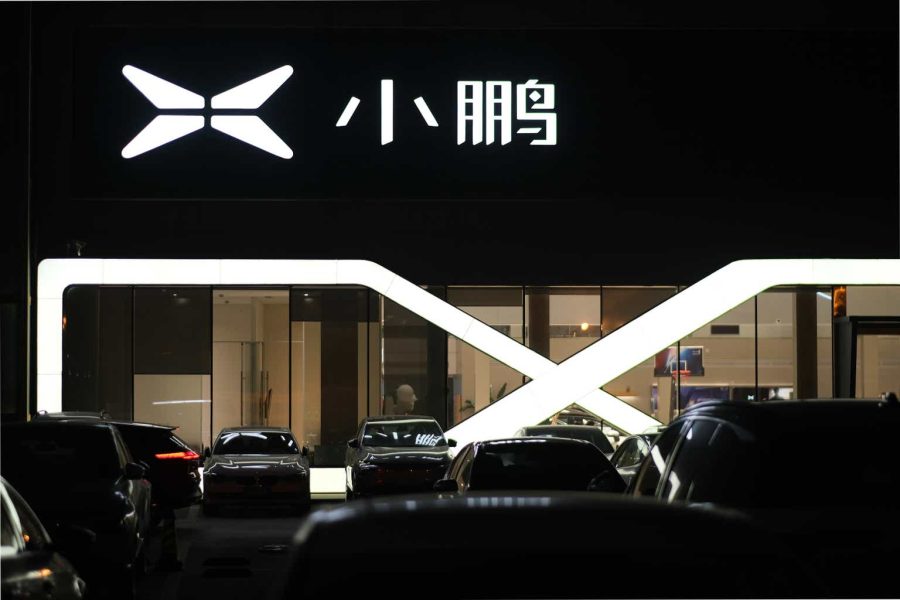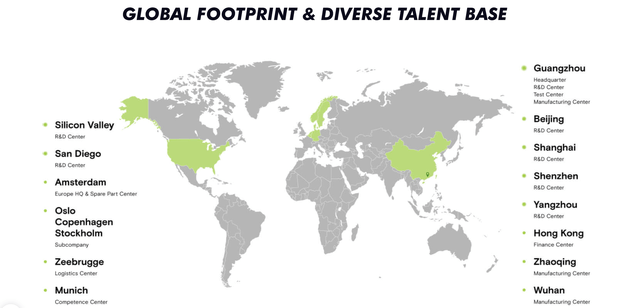Summary:
- The valuation is neither cheap nor expensive, but you could buy the highly profitable BYD at a similar price.
- The development of revenue and margins is stagnating while operating in highly competitive markets.
- The long list of risks shows the negative aspects that could lurk in the future.
- Further share dilution is also likely.
Robert Way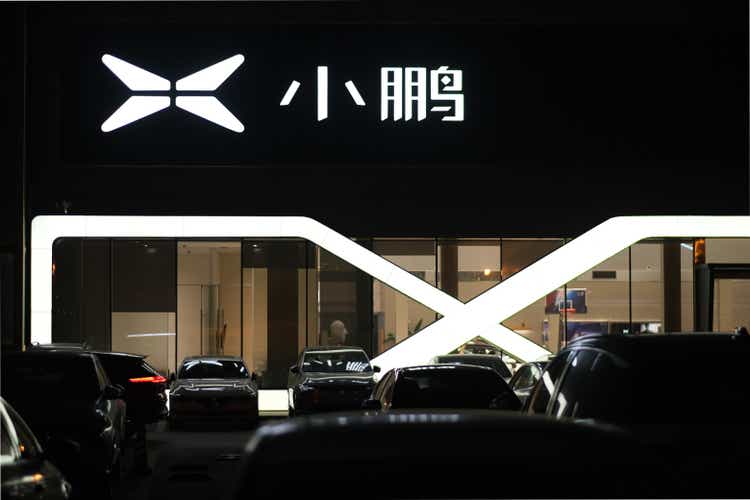
Investment Thesis
XPeng (NYSE:XPEV) continues to achieve rising car sales figures, but this has not led to significantly higher sales and better margins in the past two years. It is questionable whether this trend will continue, given the immense competitive pressure. The company is trying to expand internationally, but so are many competitors. The valuation seems neither cheap nor expensive to me, but I could buy the market leader BYD for a similar price. The available cash will probably only be sufficient for another 1-2 years, which suggests that the share dilution of the past will continue. Overall, I have found many negative aspects and risks in my analysis but not many positive aspects that favor a buy rating.
Company Overview
XPeng, founded in 2014, is a Chinese EV manufacturer that, according to the company, produces “Smart EVs that appeal to the large and growing base of technology-savvy middle-class consumers.” The company is also considering extending its product range “from road EVs to ones that fly.” which means entering the space of flying electric passenger drones, but I did not find any near-term plans for this.
The company is also making efforts to expand globally, for example, in the French market, Egypt, and Thailand. These partnerships are initially very limited in scope, as seen in the quote below, but they show the company’s strategy going forward. The Chinese market is highly competitive. Currently, several Chinese companies are expanding into international markets, where they hope to enter less competitive markets and possibly achieve better margins.
A joint venture between Arun Plus Group and MGC-ASIA, officially announced the strategic partnership with 12 dealers at the contract signing ceremony in Thailand. This milestone marked a new chapter for XPeng’s international strategy in the Thai and Southeast Asian markets.
Industry Overview
I recently covered the EV industry and outlook, especially in the Chinese market, extensively in an almost 5,000-word article called “Power Shift Part 2: Western Brands In China’s EV Market.” The article covers not just China but also many aspects of the electric car industry and general trends. I recommend that interested investors in the automotive market read the article as it goes into detail not only on the Chinese markets but also shows the growing importance of the so-called rest of the world. This table shows that in 2023, every third of new cars sold in China will be an EV, which is significantly more than in Europe or the US market.
Power Shift Part 2: Western Brands In China’s EV Market
The past: Financial Progress & Trends.
First, a short overview over a longer period for revenues, expenses, and net income. This does not look convincing, as sales in the last quarter were only as high as in 2022. Although there were new record sales in the previous quarter (Q4 2023), this chart does not indicate long-term stable revenue growth.
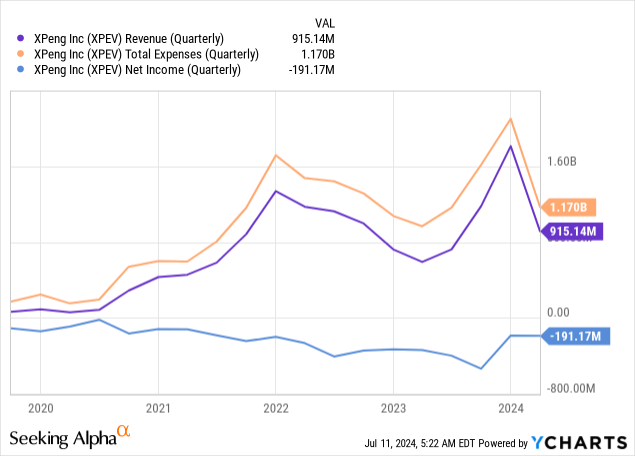
Let´s have a look at the margins, which are obviously negative because the company is not yet profitable, but the development is still an important factor in analyzing companies. Just recently, I wrote an article about a competitor, Li Auto, where these numbers were significantly better, with a 22% gross profit margin and a 9% return on assets.
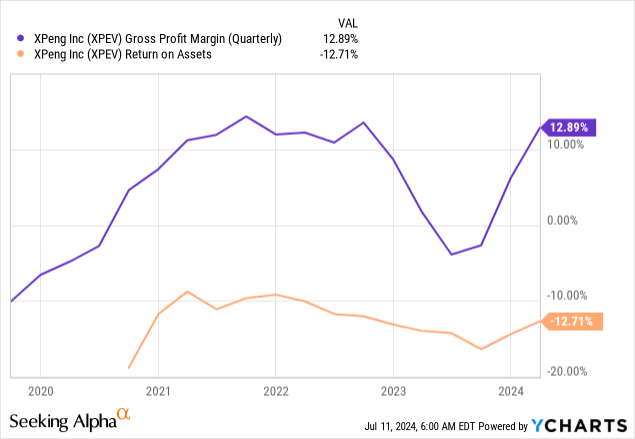
So far, we have learned that revenues tend to stagnate, margins remain stable at best, and the return on assets tends to fall. This is even though vehicle deliveries are continuing to rise. This demonstrates the immense competitive pressure, especially in the Chinese market, which forces companies to lower their prices. Here are the vehicle deliveries in 2023 compared to the previous year.
As the company’s recently published report shows, this positive delivery trend continued in the first half of 2024, with a +26 % YoY increase.
In June, XPeng delivered 10,668 Smart EVs, representing a 24% increase year-over-year and up 5% over the prior month. Overall, Xpeng delivered 52,028 Smart EVs in the first half year of 2024, a 26% increase from last year.
XPeng Announces Vehicle Delivery Results for June and First Half 2024
A comparison of the profit margin with some pure electric car competitors shows that, although significantly less profitable competition exists, XPeng is still far away from the market leaders Tesla (TSLA) and BYD (OTCPK:BYDDF); the graph below ranks the most profitable to the least profitable company.
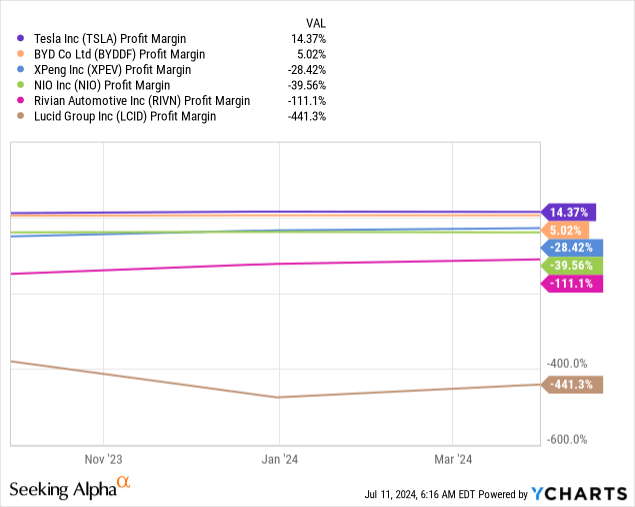
The present: Valuation & current developments
The company is currently valued at an enterprise value of $4.4B. The market cap is $7.1B, which means there is a net cash position of about $2.6B, which is not that much: according to the income statement, the net loss over the last 12 months was $1.3B. As seen below, analysts expect the company to remain unprofitable until at least 2026, which means that the existing cash will most likely not be sufficient until profit is reached, and further financing will be necessary.
Defining whether the valuation of unprofitable companies is low or high can be challenging and even differ from industry to industry (for example, very scalable software companies probably deserve a premium compared to manufacturers). So, let´s look at a few different metrics compared to competitors. The graph below ranks companies from the cheapest to the most expensive. Again, it ranks XPeng in third place.
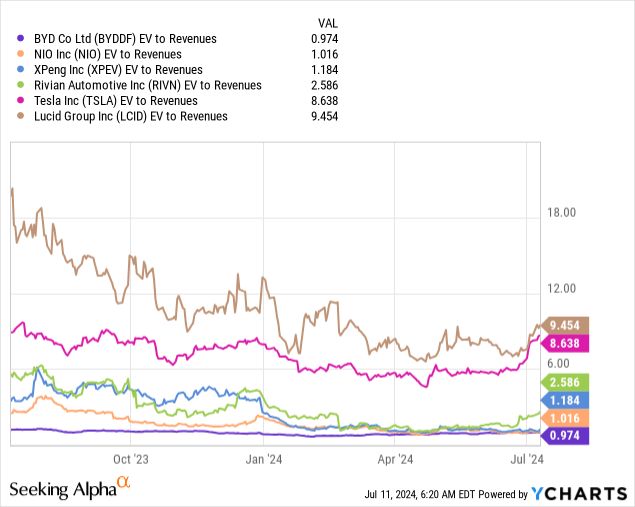
Another helpful metric is the return on invested capital (ROIC). Automobile production requires substantial investments, especially in the beginning, but over time, the metric should improve as existing plants continue to produce. Additionally, research and development might lead to increased production efficiency. Again, Tesla and BYD float above all and have rising ROIC. Again, XPeng is in third place but shows decreasing ROIC, except for the last quarter.
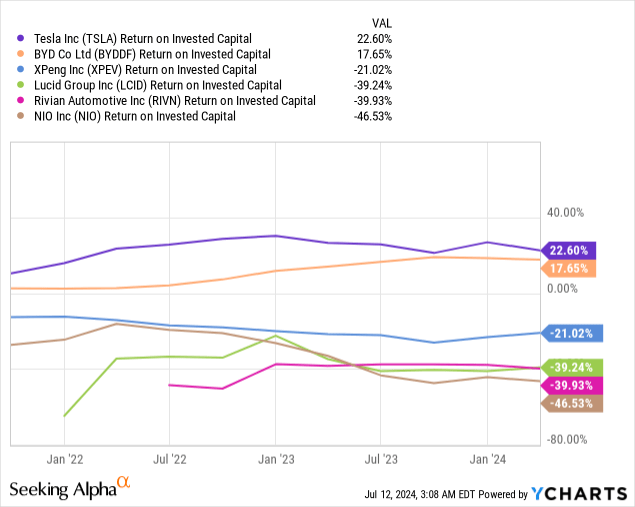
The future: Outlook
Let’s also look at the earnings estimates for the next few years and the historical earnings revisions. In my opinion, these two metrics go well together. Earnings estimates are interesting; however, remember that these are only estimates, and the reality could turn out to be very different. The earnings revisions show whether analysts’ estimates have been revised upwards or downwards in the past.
Here, too, the outlook is mixed: sales are expected to rise sharply, but the company will probably remain in the red for several more years. However, historical earnings revisions have been quite positive. However, I would like to point out that I am very cautious when it comes to estimates. The automotive sector is changing extremely quickly, and new companies are continuing to enter the market, such as the smartphone giant Xiaomi
Risks
Which brings us to the risks. I believe the already mentioned competitive landscape is the most significant risk, especially for smaller, currently unprofitable but fast-growing companies. What can assure investors that the growth will continue over the next three or five years? I can’t see any evident signs that this is the case. This applies not only to XPeng but to manufacturers in general.
Companies are putting each other under price pressure, which puts the current profitable market leaders in a better position. They can give up part of their margin to increase the pressure on the unprofitable competition, such as XPeng. I have analyzed the electric car market in detail several times, and I believe there are simply too many manufacturers at the moment. The market will consolidate somewhat in the next few years. Too many manufacturers are operating with extreme losses in some cases.
Furthermore, although the Chinese market is the largest electric car market in the world, this also means that it will probably be the first market to become saturated in the future. Sooner or later, growth will level off.
The international expansion strategy could lead to success, but again, there is no guarantee. Of course, XPeng is not the only Chinese company trying to do this; here, too, BYD is already in a better position as it already has a better-known brand and more financial power. And if companies want to sell abroad on a large scale, it is worth building production facilities there at some point, which BYD is planning to do in Turkey and Hungary, for example. This step would require considerable capital investment from XPeng. A statement by Brian Gu, co-president, shows that this is a possibility.
We have to work around what is required to compete there. Right now, we are making entries into markets with our products produced in China. It’s small quantities, initial steps, but we’re making products as local as we can. But, in the event that we need to make manufacturing or supply chains or other areas we need to invest in order to compete, we may have to do that.
The company has to deal with considerable political risks, for example in China itself, where the government determines how many new cars can be registered. But there are also political risks for Chinese companies in the West, where they have now declared war on Chinese electric vehicles because they threaten important domestic industries and millions of jobs (if you include manufacturers and their suppliers). In other words, the electric car market is increasingly becoming another sideshow in the West’s wider economic war against China. I am not sure whether new production facilities in Europe would be the solution or whether the protectionist steps taken by the USA and Europe will possibly go so far in the future that even this will become more difficult for Chinese companies.
Another significant disadvantage for current shareholders is that the existing cash will likely soon be used up, causing further share dilution. As can be seen in the next section, this would continue the trend.
Share dilution, insider trades & SBCs
For me, these three things are standard checks I make in every article, as excessive stock dilution and stock-based compensation can put us, shareholders, at a disadvantage. In addition, insider trades sometimes contain valuable info about the confidence of management itself. What can we see? SBCs are not excessively high, but the share dilution is substantial. I could not find information about insider trades.

Conclusion
Overall, I don’t see reasons to invest. Car sales are still rising, but how can investors be sure this will continue, given the competitive pressure? But it has to continue as the company is not profitable and is still a small producer (52,00 cars sold in the first six months of 2024). Moreover, rising sales have not led to substantially rising revenue and better margins in the past two years.
The company seems not highly valued, for example, in terms of EV/sales. But for a very similar price, I could buy BYD (OTCPK:BYDDF), a bigger, better-known, and profitable company. Or I could buy a world-renowned, highly profitable luxury brand like Porsche (OTCPK:POAHY), which also pays a high dividend. So why should I buy XPeng instead? I can’t find convincing reasons.
The long list of risks shows the negative aspects that could lurk in the future. Further share dilution is also likely. Therefore, I give the stock a sell rating. Finally, I would like to include a quick checklist summarizing some essential aspects. I have to answer all of these points negatively.
|
Investor’s Checklist |
Check |
Description |
|
Rising revenues? |
No |
Increasing over longer periods |
|
Improving margins? |
No |
Possible competitive edge |
|
PEG ratio below one? |
No |
PEG ratio below one may suggest undervaluation |
|
Sufficient cash reserves? |
No |
Vital for the survival & growth, especially of unprofitable companies |
|
Rewards shareholders? |
No |
Returning capital to shareholders |
|
Shareholder negatives? |
Yes |
Actions that disadvantage shareholders |
|
Stock in an uptrend? |
No |
Trading above its 200-day moving average? |
Editor’s Note: This article discusses one or more securities that do not trade on a major U.S. exchange. Please be aware of the risks associated with these stocks.
Analyst’s Disclosure: I/we have a beneficial long position in the shares of BYDDF either through stock ownership, options, or other derivatives. I wrote this article myself, and it expresses my own opinions. I am not receiving compensation for it (other than from Seeking Alpha). I have no business relationship with any company whose stock is mentioned in this article.
Seeking Alpha’s Disclosure: Past performance is no guarantee of future results. No recommendation or advice is being given as to whether any investment is suitable for a particular investor. Any views or opinions expressed above may not reflect those of Seeking Alpha as a whole. Seeking Alpha is not a licensed securities dealer, broker or US investment adviser or investment bank. Our analysts are third party authors that include both professional investors and individual investors who may not be licensed or certified by any institute or regulatory body.
